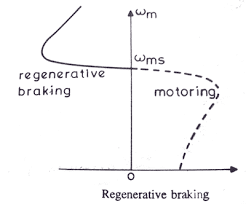Regenerative braking in Three phase Induction motors

This type of braking is possible in normal stator fed Induction motors, if the no. of poles of machine can be changed during running condition by using a special arrangement. à This is obvious that this would be possible in squirrel cage induction motor. No. of poles in stator= No. of poles in rotor (Not necessary no. of phases) à Thus when braking is desired the no. of poles is increased usually by a factor of 2. à The synchrounous speed of revolving field thus becomes half and therefore the induction motor goes into generating mode as the slip becomes negative. Consequently the speed reduces and when it reaches near the new synchronous speed, Power supplt to the motor is switched off. Subsequently it requires mechanical braking to bring the motor to rest. à Since electrical power is fed to the main at the loss of kinetic energy of the rotor this method is known as regenerative braking. à With much progress in potential energy during the last cayed frequency drives are available fo